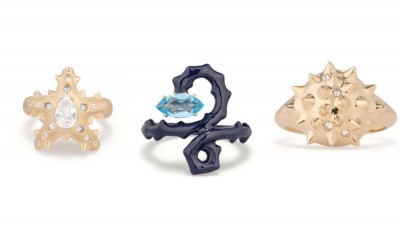GemFair Aims at Creating a Sustainable Market for ASM Diamond
What does traceability of a diamond mean? Mrs Feriel Zerouki, Senior Vice-President Industry Relations and Ethical Initiatives, De Beers Group and General Manager, GemFair, explains it to us, starting from the small-scale diamond miners
What led De Beers to create GemFair? How long did it take to launch the product and what forces (investments) were involved?
The artisanal and small-scale diamond mining (ASM) sector is an important source of global diamond production and provides a critical livelihood for people working in the sector. However, due to a lack of regulation, ASM participants lack access to formal markets. In addition, legacy concerns regarding conflict areas mean these diamonds are often perceived negatively by consumers, when the reality is the vast majority of the production is not from conflict zones. GemFair aims at creating a sustainable market for these gems.
The programme uses digital technology to trace ASM diamonds and requires all participating sites to meet minimum operating and ethical standards aligned with the OECD. GemFair hopes to create equal opportunities for artisanal miners and improve the standards and reputation of the sector. The launch of the GemFair pilot in Sierra Leone took around 18 months: we opened our buying office, built a robust digital solution and created suitable artisanal mining standards. Thanks to our NGO partner, Diamond Development Initiative, sites were certified ahead of our first purchase. We’ve devoted significant investment to our operations in-country: securing the necessary permits, developing a training programme and hiring a team in charge for running the GemFair programme on-the-ground.
What does it mean in practice to be able to trace the path of a diamond?
Our digital solution provides transparency, traceability and assures that every diamond purchased has been responsibly sourced from an approved mine site that meets GemFair’s operating standards. The process involves recording the diamond on the GemFair app at the time it was discovered at the mine site, which is geo-tagged to the app. It is logged onto the app by photographing it and it is taken to GemFair’s buying office, where the buyer reconciles the diamond with the information on the app. GemFair diamonds over a certain size are also logged onto the Tracr blockchain platform.
What advantages does it bring to the life of mining communities and along the entire supply chain? How has the life of miners in Sierra Leone changed?
GemFair is still in the pilot phase; however, there’s been a lot of interest in the programme from participating sites. We hope that GemFair will improve miners’ overall livelihoods by enhancing working conditions. We also hope the programme will improve environmental standards in the sector. In addition, GemFair supports the Government of Sierra Leone in formalising the sector, by bringing traceability to the supply chain. We hope the integration of ASM production into the global market will increase tax revenue for government. We also hope GemFair will contribute to better infrastructure and foster enhanced market linkages within the sector.
The artisanal and small-scale diamond mining (ASM) sector is an important source of global diamond production and provides a critical livelihood for people working in the sector. However, due to a lack of regulation, ASM participants lack access to formal markets. In addition, legacy concerns regarding conflict areas mean these diamonds are often perceived negatively by consumers, when the reality is the vast majority of the production is not from conflict zones. GemFair aims at creating a sustainable market for these gems.
The programme uses digital technology to trace ASM diamonds and requires all participating sites to meet minimum operating and ethical standards aligned with the OECD. GemFair hopes to create equal opportunities for artisanal miners and improve the standards and reputation of the sector. The launch of the GemFair pilot in Sierra Leone took around 18 months: we opened our buying office, built a robust digital solution and created suitable artisanal mining standards. Thanks to our NGO partner, Diamond Development Initiative, sites were certified ahead of our first purchase. We’ve devoted significant investment to our operations in-country: securing the necessary permits, developing a training programme and hiring a team in charge for running the GemFair programme on-the-ground.
What does it mean in practice to be able to trace the path of a diamond?
Our digital solution provides transparency, traceability and assures that every diamond purchased has been responsibly sourced from an approved mine site that meets GemFair’s operating standards. The process involves recording the diamond on the GemFair app at the time it was discovered at the mine site, which is geo-tagged to the app. It is logged onto the app by photographing it and it is taken to GemFair’s buying office, where the buyer reconciles the diamond with the information on the app. GemFair diamonds over a certain size are also logged onto the Tracr blockchain platform.
What advantages does it bring to the life of mining communities and along the entire supply chain? How has the life of miners in Sierra Leone changed?
GemFair is still in the pilot phase; however, there’s been a lot of interest in the programme from participating sites. We hope that GemFair will improve miners’ overall livelihoods by enhancing working conditions. We also hope the programme will improve environmental standards in the sector. In addition, GemFair supports the Government of Sierra Leone in formalising the sector, by bringing traceability to the supply chain. We hope the integration of ASM production into the global market will increase tax revenue for government. We also hope GemFair will contribute to better infrastructure and foster enhanced market linkages within the sector.
What are GemFair next countries of application? Could be it involved also in traceability of minerals and other precious stones? If not, why only diamonds?
We’re still in the pilot phase, so it’s too early to speculate on where else GemFair could be introduced in the future. However, any location we consider must meet our minimum operational and political criteria. The technology could theoretically be applied to other minerals, but our focus right now is on diamonds.
Is an ASM diamond or a laboratory diamond more sustainable?
Broad comparisons are hard to make. However, a responsibly-sourced ASM diamond provides a critical source of livelihood for FZ people living in countries where there are often limited options to earn an income. And through programmes such as GemFair, these diamonds have the potential to improve the lives of local miners and their families. Labgrown diamonds don’t have this same potential, especially since the vast majority of profits from lab-grown diamonds flow back to private investors. Lab-grown diamonds also require huge amounts of energy to create, with consequent impact on the environment.
What processes are used to make synthetic diamonds?
There are two methods for producing labgrown diamonds: High Pressure High Temperature (HPHT) and Chemical Vapour Deposition (CVD). Both processes require the use of industrial manufacturing equipment and substantial amounts of energy.
Have you foreseen traceability also for the raw materials of the laboratory diamond?
De Beers Group’s efforts are focused on the traceability of natural diamonds through GemFair and the Tracr blockchain platform. Both initiatives assure that the diamonds registered on the platforms are natural diamonds and responsibly sourced. We would welcome initiatives that provide consumers with more transparency regarding lab-grown diamonds and their supply chains. Their producers often make claims regarding provenance and sustainability, but these need to be interrogated on a case-by-case basis.
We’re still in the pilot phase, so it’s too early to speculate on where else GemFair could be introduced in the future. However, any location we consider must meet our minimum operational and political criteria. The technology could theoretically be applied to other minerals, but our focus right now is on diamonds.
Is an ASM diamond or a laboratory diamond more sustainable?
Broad comparisons are hard to make. However, a responsibly-sourced ASM diamond provides a critical source of livelihood for FZ people living in countries where there are often limited options to earn an income. And through programmes such as GemFair, these diamonds have the potential to improve the lives of local miners and their families. Labgrown diamonds don’t have this same potential, especially since the vast majority of profits from lab-grown diamonds flow back to private investors. Lab-grown diamonds also require huge amounts of energy to create, with consequent impact on the environment.
What processes are used to make synthetic diamonds?
There are two methods for producing labgrown diamonds: High Pressure High Temperature (HPHT) and Chemical Vapour Deposition (CVD). Both processes require the use of industrial manufacturing equipment and substantial amounts of energy.
Have you foreseen traceability also for the raw materials of the laboratory diamond?
De Beers Group’s efforts are focused on the traceability of natural diamonds through GemFair and the Tracr blockchain platform. Both initiatives assure that the diamonds registered on the platforms are natural diamonds and responsibly sourced. We would welcome initiatives that provide consumers with more transparency regarding lab-grown diamonds and their supply chains. Their producers often make claims regarding provenance and sustainability, but these need to be interrogated on a case-by-case basis.






